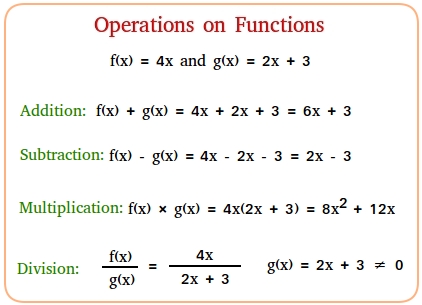Operations on functions
This lesson will teach you how to perform operations on functions. Basically, you can add, subtract, multiply, and divide functions.
Examples showing how to do operations on functions.
How to do addition of functions
( f + g )(x) = f(x) + g(x)
Example #1
Find f + g if f(x) = 2x - 7 and g(x) = 5x + 8
(f + g)(x) = f(x) + g(x)
= 2x - 7 + 5x + 8
= 2x + 5x + - 7 + 8
= 7x + 1
How to do subtraction of functions
( f - g )(x) = f(x) - g(x)
Example #2
Find f - g if f(x) = 3x + 9 and g(x) = 6x - 3
(f - g)(x) = f(x) - g(x)
= 3x + 9 - (6x - 3)
= 3x + 9 - 6x - - 3
= 3x + 9 - 6x + 3
= 3x - 6x + 9 + 3
= -3x + 12
( f × g )(x) = f(x) × g(x)
Example #3
Find f × g if f(x) = x + 1 and g(x) = x + 5
(f × g)(x) = f(x) × g(x)
= (x + 1) × (x + 5)
= x × x + x × 5 + 1 × x + 1 × 5
= x2 + 5x + 1x + 5
x2 + 6x + 5
How to do division of functions
( f / g )(x) = f(x) / g(x) with g(x) ≠ 0
Example #4
Find f / g if f(x) = x2 - 1 and g(x) = x + 1
(f / g)(x) = f(x) / g(x)
= (x2 - 1) / (x + 1) with x + 1 ≠ 0
= [(x - 1) × (x + 1)] / x + 1 with x + 1 ≠ 0
= x - 1 with x + 1 ≠ 0
= x - 1 with x ≠ -1
Notice that we were able to cancel x + 1 since x + 1 is on top and at the bottom in the rational expression.
Summary
Let f and g be functions. Take a look at the following figure to see how we can perform these operations on a function.
